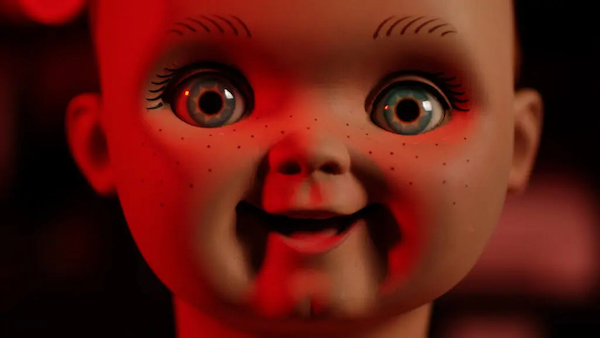Movie review by Greg Carlson
Kyra Elise Gardner, the daughter of special effects legend Tony Gardner, writes and directs “Living With Chucky,” an affectionate labor-of-love account covering the long evolution of the “Child’s Play” horror franchise. Beginning in 1988, the series built a devoted cult following around the popularity of Chucky, the seemingly innocent toy inhabited by the soul of a foul-mouthed serial killer and psychopath voiced by the great Brad Dourif. Gardner’s documentary unfolds in part like a comfy home video but struggles to transcend the contours of a standard behind-the-scenes featurette and/or electronic press kit that would be included with the bonus material on a DVD or Blu-ray.
“Living With Chucky” leans heavily on talking head interviews with several of the key players in the “Child’s Play” universe, including the elder Gardner, Dourif, Dourif’s daughter Fiona, writer/director/Chucky creator Don Mancini, producer David Kirschner, and original Andy Barclay portrayer Alex Vincent, to name just a few. The filmmaker organizes the anecdotes in mostly chronological order, working through the half-dozen sequels (and touching on the episodic series made for Syfy) as the main chapter stops. At its best, “Living With Chucky” grapples with the challenges of bringing the proudly physical doll to gloriously puppeteered life.
Given the incredible achievements of Tony Gardner, perhaps a better movie might have emerged focusing on the full breadth of his career. From very first professional gig appearing as more than one zombie in Michael Jackson’s “Thriller” music video to realizing the self-amputation in Danny Boyle’s “127 Hours” to helping design the Daft Punk helmets, Gardner’s creative output with Alterian, Inc. boasts a lengthy list of highlights on dozens of feature films, TV shows, commercials, and music videos. Toward the end of “Living With Chucky,” Kyra Gardner gets personal, recounting the challenges of growing up with a father whose work kept him away from home on many important occasions.
Of course, Chucky is a bigger celebrity than Tony Gardner, and the movie relies on the comments of Mancini to put the legacy of the freckled redhead into perspective. Killer toys, dummies, and dolls have long provided the horror and fantasy genres with any number of memorable touchstones. The subversion and/or perversion of childhood innocence and safety through the malevolent influence of dangerous doppelgangers often alludes to some kind of trauma experience or family dysfunction. Chucky comes from a line of predecessors including James Cruze’s “The Great Gabbo,” the amazing “Living Doll” episode of “The Twilight Zone” (mentioned twice near the beginning of “Living With Chucky”) and the “Amelia” chapter in “Trilogy of Terror,” though the documentary spends little time contemplating cinematic ancestors.
Mancini directly addresses the ways in which he sought to introduce a greater degree of queerness into the “Child’s Play” films, but the conversation surrounding the addition of Chucky and Tiffany’s genderfluid offspring Glen (despite reactions by Jennifer Tilly, John Waters, Billy Boyd, and others) never quite goes as deep as one would like. Gardner also entirely skips over the 2019 reboot, perhaps a sore subject given the absence of the original creative team. Despite that omission, “Living With Chucky” illustrates the realities of a tough business, where diminishing box office receipts translate to smaller and smaller budgets. That said, I wouldn’t count Chucky out just yet.
